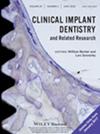Metal-Free Custom-Made Zirconia Implants—A Prospective 5-Year Follow-Up Single-Arm Clinical Trial
Abstract
Background
Dental implants made of zirconia (ZrO2) are a potential alternative for titanium implants in dentistry because of their good biocompatibility, mechanical properties and excellent aesthetic results. However, solid long-term scientific data to prove clinical success of ZrO2 implants are scarce.
Aim
The aim of this study was to describe and to examine the clinical performance of custom-made two-piece ZrO2 implants, to identify possible influencing factors: a) manipulation of the implant after placement and b) the occlusal scheme on the survival rate, and to evaluate the performance of the implant-supported crown. This follow-up study collected and examined the 5-year data to answer the main question: What are the survival and the success rates of custom-made ZrO2 implants in the maxillary premolar region after 5 years?
Material and Methods
Of the 31 included patients in this prospective 5-year follow-up single-arm clinical trial, 30 received a custom-made ZrO2 implant to replace a missing single maxillary premolar, which was subsequently restored with a lithium disilicate crown. Parameters regarding clinical performance, marginal bone-level (MBL) changes, and patient-related outcome measures (PROMs) were assessed preoperatively, at the baseline, as well as 1 and 5 years after crown placement. Chances of survival and success of the implant were calculated and displayed using Kaplan–Meier statistics. Kaplan–Meier survival analysis was also performed with stratification based on the variables “manipulation of the implant prior to impression taking” and “occlusal scheme” and compared using log-rank tests. Bone-level moderation in time was compared using a paired samples t-test. Patient's expectations and satisfaction after 5 years were compared as a measure of fulfilled expectations, using a Wilcoxon signed-rank test. Performance of the implant-supported crowns was evaluated using validated criteria.
Results
Survival and success probabilities after 5 years were, respectively, 75.8% (95% CI [60.0%; 91.0%]) and 71.0% (95% CI [54.0%; 88.0%]) for the custom-made ZV3 implants. No significant differences in survival rate were found after stratification on “manipulation of the implant” and on “occlusal scheme.” Mean bone-level alteration between baseline and the first follow-up was +0.06 mm (95% CI [−0.23 mm; 0.12 mm]; SD = 0.42 mm) and between baseline and the second follow-up was +0.04 mm (95% CI [−0.35 mm; 0.26 mm]; SD = 0.54 mm). Patients' satisfaction for patients with implants still in function after 5 years was 91.7% (IQR = [90.5%–97.3%]), indicating satisfaction with the treatment. Pooled satisfaction in patients with successful implants after 5 years was significantly higher than patients' expressed expectations before treatment. None of the crowns failed, and no interventions were required.
Conclusion and Clinical Implications
Survival rate of these particular ZV3 implants in our study was lower than expected and clinically not acceptable. Hence, ZV3 implant placement as applied in this study cannot be recommended for clinical practice. Further research on the different appearances of mechanical failure in ZrO2 implants would be highly recommended before a larger prospective randomized clinical trial is conducted to evaluate treatment with custom-made ZrO2 dental implants.


 求助内容:
求助内容: 应助结果提醒方式:
应助结果提醒方式:


